
BRAZILIAN JOURNAL OF PHYSICS
Scope & Guideline
Driving Progress in the Physics Community
Introduction
Aims and Scopes
- Theoretical Physics:
Research articles often delve into theoretical frameworks that explore fundamental principles of physics, including quantum mechanics, relativity, and statistical mechanics. - Experimental Physics:
The journal publishes empirical studies that validate theoretical predictions, utilizing experimental setups to investigate physical properties and phenomena. - Materials Science:
A significant portion of the journal is dedicated to the study of materials, focusing on their structural, optical, and electronic properties, and how these properties can be manipulated for technological applications. - Nanotechnology:
The journal features research on nanoscale materials and their applications in various fields, including electronics, photonics, and environmental science. - Astrophysics and Cosmology:
Papers often explore cosmic phenomena, stellar dynamics, and the implications of physical theories in understanding the universe's evolution. - Biophysics and Medical Physics:
Research at the intersection of physics and biology is highlighted, particularly studies that apply physical principles to solve biological and medical problems. - Plasma Physics:
The journal includes studies on plasma behavior, particularly in astrophysical contexts and applications in fusion energy research. - Quantum Computing and Information:
Aspects of quantum information theory and its practical implementations in computing technologies are also a focus area.
Trending and Emerging
- Quantum Technologies:
An increasing number of papers are dedicated to quantum computing, quantum cryptography, and quantum information theory, reflecting the growing interest and investment in quantum technologies. - Nanomaterials and Nanotechnology:
Research on nanostructured materials, including their synthesis, characterization, and applications in various fields such as electronics and medicine, is on the rise. - Environmental Physics:
Studies addressing environmental issues, including the development of sustainable materials and energy-efficient technologies, have gained prominence, highlighting the role of physics in tackling global challenges. - Biophysics and Medical Applications:
There is a notable increase in research that applies physical principles to biological systems, particularly in medical diagnostics and therapeutic techniques. - Machine Learning in Physics:
The integration of machine learning techniques to analyze data and model complex systems is becoming a significant trend, showcasing the interplay between physics and computational sciences. - Complex Systems and Nonlinear Dynamics:
Research focusing on complex systems, chaos, and nonlinear dynamics is increasingly featured, reflecting a broader interest in understanding emergent behavior in physical systems.
Declining or Waning
- Classical Mechanics:
While still relevant, classical mechanics has seen a decrease in dedicated studies as the field shifts towards more complex systems and interactions that necessitate quantum or relativistic frameworks. - Traditional Nuclear Physics:
Research focusing exclusively on traditional nuclear physics without the integration of advanced computational methods or novel experimental techniques has diminished, as the field evolves towards interdisciplinary approaches. - Basic Optical Studies:
Papers that solely focus on fundamental optical properties without application to novel materials or technologies have decreased, indicating a trend towards more applied research. - Static Theories of Solid State Physics:
Research that does not incorporate dynamic or time-dependent effects in solid-state physics is less frequently published, as the community emphasizes more complex, time-resolved phenomena.
Similar Journals
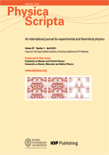
PHYSICA SCRIPTA
Nurturing Knowledge and Innovation in Physics Since 1970PHYSICA SCRIPTA, established in 1970 and published by IOP Publishing Ltd, is a prestigious journal dedicated to the broad fields of physics, encompassing topics such as atomic and molecular physics, condensed matter physics, and mathematical physics. With an impressive commitment to advancing scientific knowledge, it holds a significant standing in the academic community, evidenced by its Q2 and Q3 rankings across various categories in 2023. The journal is instrumental for researchers, professionals, and students seeking to disseminate and engage with high-quality research, fostering collaboration and innovation within the field. Although it currently does not offer open access options, its robust editorial standards ensure the dissemination of impactful studies, contributing to its rising citation metrics. Published from the United Kingdom, PHYSICA SCRIPTA continues to be a vital resource for contemporary developments in physics, paving the way for future discoveries.
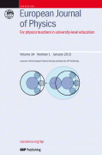
EUROPEAN JOURNAL OF PHYSICS
Empowering Scholars with Rigorous InsightsEuropean Journal of Physics, published by IOP Publishing Ltd, is a premier international journal serving the diverse field of physics and astronomy. With a commitment to advancing scientific knowledge since its inception in 1980, the journal provides a platform for original research articles, reviews, and topical discussions in various domains, including theoretical and experimental physics. Operating out of the United Kingdom, the journal has achieved a commendable Q2 ranking in the Physics and Astronomy (miscellaneous) category for 2023, reflecting its robust influence in the academic community, alongside a notable Scopus Rank that underscores its relevance in both the Social Sciences and General Physics and Astronomy fields. Although it does not currently offer open access, the journal's traditional publication model ensures rigorous peer review, maintaining high scholarly standards that are imperative for researchers, professionals, and students striving to stay ahead in their respective fields. Don't miss the opportunity to engage with cutting-edge research and contribute to the ongoing dialogue in physics by accessing this vital resource.

JOURNAL OF THE KOREAN PHYSICAL SOCIETY
Bridging Ideas and Innovations in Physical ResearchJOURNAL OF THE KOREAN PHYSICAL SOCIETY is a prominent academic journal dedicated to advancing the field of physics, published by the prestigious Korean Physical Society. With its extensive contribution to the scientific community since its inception in 1996, this journal serves as an essential platform for the dissemination of innovative research findings in various branches of physical science. Despite its current categorization in Q4 and a ranking reflecting its early-stage impact relative to peers, it remains a valuable resource for researchers, professionals, and students eager to explore developments in general physics and astronomy. The journal is accessible in both print and electronic formats, making it convenient for a global audience. Each issue aims to foster collaboration and knowledge-sharing within the field, ensuring that it remains relevant and instrumental in shaping future research directions. Located in South Korea, the journal continues to nurture a vibrant academic community, contributing to the ongoing dialogue in the global scientific arena.

Jurnal Fizik Malaysia
Championing Quality Research for a Deeper Understanding of Physics.Jurnal Fizik Malaysia is a prominent academic journal dedicated to advancing the field of physics, published by the esteemed Institut Fizik Malaysia. With an aim to foster knowledge dissemination and research collaboration among physicists, the journal serves as a vital platform for original research articles, reviews, and technical notes that cover various sub-disciplines of physics. Although the journal operates under a traditional subscription model, its commitment to quality has been bolstered by a rigorous peer-review process, ensuring high academic standards. Researchers and students in Malaysia and beyond are encouraged to engage with this journal, contributing to a deeper understanding of physical sciences and its applications. Moreover, with its ISSN 0128-0333, Jurnal Fizik Malaysia continues to play a significant role in the scientific community, enhancing visibility and accessibility for local and international research outputs in the ever-evolving landscape of physics.
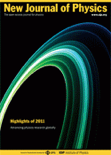
NEW JOURNAL OF PHYSICS
Shaping the future of physics through collaboration.NEW JOURNAL OF PHYSICS, published by IOP Publishing Ltd, is a prestigious open-access journal that has been at the forefront of the physics community since its inception in 1998. With an impact factor that places it in the Q1 category of Physics and Astronomy (miscellaneous) and a commendable ranking of #49 out of 243 in the general physics and astronomy category according to Scopus, this journal is recognized for its significant contribution to advancing research in the field. The journal caters to a broad scope of topics, providing a platform for the dissemination of cutting-edge research findings and innovative theoretical explorations. Operating from the United Kingdom, it offers a truly international perspective, making its contents accessible and impactful to a global audience. With robust open-access options, the NEW JOURNAL OF PHYSICS ensures that research findings are freely available, promoting collaboration and knowledge sharing among researchers, professionals, and students alike. This commitment to accessibility, combined with its high-quality content, makes it an essential resource for anyone engaged in the physics community.

ACTA PHYSICA SINICA
Empowering Researchers with Groundbreaking InsightsACTA PHYSICA SINICA is a prominent journal published by the Chinese Physical Society, dedicated to the dissemination of groundbreaking research in the field of physics and astronomy. Established in 1993, this journal has consistently contributed to the scientific community by publishing high-quality articles that cover a wide range of topics within general physics and related disciplines. Although currently classified in Q4 of the physics and astronomy category by Scopus, ACTA PHYSICA SINICA plays an important role in fostering collaboration and communication among researchers in China and around the world. With a substantial readership, this journal is poised to remain a valuable resource for professionals, researchers, and students alike. By providing in-depth analysis and insights, it aims to advance the understanding and application of physical principles in various technological and scientific advancements. The journal is accessible via subscription, ensuring that contributors and readers can engage with the evolving landscape of physics research. For more information, visit the publisher's website.
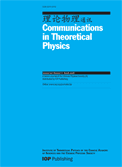
COMMUNICATIONS IN THEORETICAL PHYSICS
Advancing the frontiers of theoretical physics.COMMUNICATIONS IN THEORETICAL PHYSICS is a distinguished journal published by IOP Publishing Ltd, focusing on the broad and evolving field of theoretical physics. With an ISSN of 0253-6102 and an E-ISSN of 1572-9494, this journal provides a platform for the dissemination of innovative research that contributes to the understanding of complex physical concepts. Situated in the United Kingdom, it has established itself as a pivotal resource from 1996 to 2024, achieving a commendable Q2 ranking in the category of Physics and Astronomy (miscellaneous) for 2023. With a Scopus ranking of #18 out of 81 in its category, demonstrating a 78th percentile, this journal plays a crucial role in enhancing scholarly communication among researchers, professionals, and students alike. Although it does not currently offer Open Access options, the journal's comprehensive scope and commitment to high-quality peer-reviewed research underline its significance in the scientific community, making it an essential reading for anyone engaged in theoretical physics.

Romanian Journal of Physics
Elevating physics discourse to new heights.Welcome to the Romanian Journal of Physics, a distinguished platform dedicated to advancing the field of physics and astronomy since its inception. Published by EDITURA ACAD ROMANE, this journal plays a pivotal role in disseminating high-quality research from Romania and around the globe, with an impressive impact factor that reflects its rigorous academic standards. With a focus on a broad range of topics in general physics and astronomy, it proudly maintains a Q2 ranking in its category for 2023, positioning itself among the top journals in the field. The journal, which has been converging valuable research contributions from 2008 until 2024, is accessible to a wide audience of researchers, professionals, and students interested in the latest developments and discoveries in physics. While it operates under a traditional publication model without Open Access, its commitment to quality research ensures that the contributions featured in its pages resonate well within the scientific community. We invite you to explore the rich findings published in the Romanian Journal of Physics and to engage with the vital discussions shaping the future of physics.

Physics
Unveiling the Universe: Insights in Physics and AstronomyPhysics, published by MDPI, is an open-access journal that commenced in 2019 and has quickly established itself as a significant contributor to the field of physics and astronomy. With a respectable impact factor and categorized in the Q2 quartile for 2023, this journal serves a broad spectrum of topics within the discipline, fostering innovative research and insights. As part of the MDPI portfolio, known for promoting high-quality, peer-reviewed research, Physics aims to provide a platform for scholars, professionals, and students to publish their findings and engage with contemporary debates in the field. The journal's accessibility, paired with its commitment to scientific excellence, ensures that research is readily available to a global audience, which is crucial for advancing knowledge and collaboration in physics. Located in the heart of Switzerland at ST ALBAN-ANLAGE 66, CH-4052 BASEL, the journal enjoys a position at the nexus of cutting-edge research and academia.
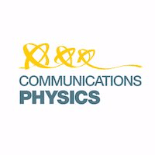
Communications Physics
Advancing the frontiers of Physics and Astronomy.Communications Physics is a premier open access journal published by Nature Portfolio, dedicated to disseminating high-quality research in the field of Physics and Astronomy. Since its inception in 2018, the journal has rapidly established itself as a vital platform for innovative scientific communication, boasting an impressive Impact Factor and achieving Q1 status in the 2023 category of Physics and Astronomy (miscellaneous). With a Scopus rank of #31 out of 243, placing it within the 87th percentile, Communications Physics attracts a global audience of researchers, professionals, and students eager to engage with cutting-edge findings. The journal supports open access, ensuring that research is freely available to the public, which enhances its visibility and encourages broader discussions within the scientific community. Located in Berlin, Germany, Communications Physics aims to bridge the gap between various disciplines within physics, fostering interdisciplinary collaboration and inspiring future research endeavors.